Risk prediction of enterprise human resource management based on deep learning
Abstract
BACKGROUND:
The efficiency and accuracy of risk prediction in traditional enterprise human resource management (HRM) cannot meet practical needs. In response to this deficiency, this study proposes an enterprise HRM risk intelligent prediction model based on deep learning.
METHODS:
Two tasks were completed in this study. First, based on the existing research results and the current status of enterprise HRM, the HRM risk assessment system is constructed and streamlined. Second, for the defects of Back Propagation Neural Network (BPNN) model, Seagull Optimization Algorithm (SOA) is used to optimize it. The Whale Optimization Algorithm (WOA) is introduced to promote the SOA for its weak global search capability and its tendency to converge prematurely.
RESULTS:
By simplifying the HR risk assessment system and optimizing the BPNN using the SOA algorithm, an intelligent HRM risk prediction model based on the ISOA-BPNN was constructed. The results show that the error value of the ISOA-BPNN model is 0.02, the loss value is 0.50, the F1 value is 95.7%, the recall value is 94.9%, the MSE value is 0.31, the MAE value is 8.4, and the accuracy is 99.53%, both of which are superior to the other two models.
CONCLUSIONS:
In summary, the study of the HRM risk intelligent prediction model constructed based on ISOA-BPNN has high accuracy and efficiency, which can effectively achieve HRM risk intelligent prediction and has positive significance for enterprise development.

Min Ding was born in Anhui Province, AH,CHN, in 1973.She received the B.S. degree in Economics from State Machinery Manufacturing College of Donbas Oblast, Ukraine, in 1996. She received the M.S. degree in Enterprise Management from Anhui University of Finance and Economics, China, in 2001. She received the Doctor’s degree in Enterprise Management from Liaoning University, China, in 2012.
From 1997 to 2000, she was a teaching assistant with the School of Business Administration, Anhui University of Finance and Economics, Anhui province, China. From 2000 to 2013, she was a lecturer and associate professor with the School of Business, Anhui University, Anhui province. Since 2013, she has been an associate professor with the School of Customs and Public Administration, Shanghai Customs College, Shanghai City. She is the author of three books, more than twenty articles. Her research interests include human resource management, organizational behavior and enterprise management.

Hao Wu was born in Anhui Province, CHN, in 1973. He received a B.S. degree in International Trade from the State Machinery Manufacturing College of Donbas Oblast, Ukraine, in 1996. And he earned an M.S. degree in Enterprise Management from Anhui University of Finance and Economics, China, in 2009.
From 1996 to 2005, he was a foreign sales in Anhui Technology Imp. & Exp. Co., Ltd. From 2006 to 2011, he was a senior business manager at Anhui Technology Imp. & Exp.Co., Ltd. Then, from 2011–2018, he was the import 3rd division vice-general manager in the same company. Since 2019, he has been a resource products division vice-general manager at Anhui Technology Imp. & Exp. Co., LTD. Also, he is an international business engineer.
1Introduction
In the midst of increasingly fierce market competition, in order to sustain and stabilize development, enterprises are paying more and more attention to human resources, the carriers of knowledge and skills. Some economists believe that human resources are the core and most creative and dynamic resources in an enterprise, which reflect the value of the enterprise and are related to the survival, operation and development of the enterprise [1]. However, in human resource management, due to factors such as improper planning, non compliant recruitment processes, and inadequate training, there are risks of high turnover rates, excessive consumption of enterprise resources, and low employee satisfaction. These factors may cause damage to the company’s reputation and property, so it is necessary to evaluate and predict human resource management risks [2]. The traditional HRM risk prediction method is based on tools such as Analytic Hierarchy Process and Risk Matrix Method. However, these methods require a large amount of manual calculation, so the objectivity and accuracy of HRM risk prediction results and the efficiency of HR prediction work cannot be guaranteed [3]. In recent years, deep learning technology has developed rapidly, causing far-reaching effects on automation, intelligence, and digital transformation in various fields [4, 5]. Some researchers have attempted to apply deep learning techniques to HRM work in enterprises, aiming to achieve intelligent and digital management. However, at present, there are fewer studies related to intelligent HRM risk prediction [6–10]. To fill this gap, and at the same time make HRM risk prediction automatic and reduce human resource costs, the study proposes a BP neural network (BPNN) based on Improved Seagull Optimization Algorithm (ISOA) optimization model. This paper constructs an enterprise HRM risk prediction model to achieve high-precision and intelligent HRM prediction, improve enterprise HRM capabilities, and promote enterprise development. There are two main innovations in the research. One is to propose strategies for improving SOA. Enhancing the optimization performance of SOA and utilizing ISOA to optimize BPNN, improving the model accuracy of BPNN, contribute to the research of deep learning algorithm fusion. This provides a reference for improving the accuracy of subsequent deep learning algorithm research. The second is to apply the optimization of BPNN to enterprise HRM risk prediction work, achieve intelligent HRM risk prediction, and improve the efficiency of enterprise HRM. This study summarizes and categorizes the HRM theory, simplifies the risk assessment index system of HRM, and provides a certain reference for the research and development of this theory and cross domain cooperation.
1.1Related work
Human resources are the carrier of enterprise knowledge and skills, and also the core resource of the enterprise. Currently, many researchers have agreed that human resources are the cornerstone of enterprise development, and HRM also occupies an important position in enterprise management. Therefore, many scholars have put forward their insights and opinions on HRM in enterprises. Berhil et al. reviewed and analyzed the research results related to the application of artificial intelligence in HRM in enterprises, so as to discuss the application path, application effect and development prospect of artificial intelligence technology in HRM. Their conclusions provide digitalization, intelligence and informatization for HRM Theoretical guidance [6]. Carnevale et al. explored the impact of job adjustment and company welfare on HRM during the new crown, which played an enlightening role for HR stability during the epidemic. It also had implications for the development of enterprises during the new crown epidemic [7]. Yong et al. compiled, counted and analyzed the relevant literature from 2007 to 2019. They discussed the current situation, problems and development prospects of green HRM, and pointed out the direction for the research in the field of green HR [8]. Pham et al. conducted a comprehensive analysis and review of the current problems, development status and challenges encountered in green HRM. They also proposed corresponding strategies to solve the problems, and finally put forward their own views on the future development of green HR. Cross et al. explored the role of HRM in independent work and made a challenging hypothesis, which was verified based on empirical analysis [10]. The importance of HRM work was verified by analyzing and discussing the practical significance of HRM work in a study [11]. Putra et al. provided a comprehensive compilation and elaboration of the literature related to HRM, thus providing a theoretical reference for decision making on business management behavior and providing a skill enhancement and communication skills for HRM work [12]. Ansari et al. studied and explored the potential correlation and influence mechanism between green HRM efforts and the environmental behavior of corporate employees, thus providing new ideas that contribute to the development of green HRM efforts [13].
Deep learning technology is rapidly developing and is having a profound impact on automation, intelligence, and digital transformation in various fields, which is why they are attracting the attention of researchers in various fields. BPNN is an important part of deep learning technology, and its simple model structure, strong classification performance and low algorithm complexity make it an important application in various fields. Han et al. used Genetic Algorithm (GA) to optimize the structure of BPNN and achieve intelligent modeling design of products with GA-BPNN model to improve the efficiency of product design [14]. Li et al. proposed to optimize the current motion management system by using BPNN to improve the management efficiency [15]. Chen et al. constructed a research performance management evaluation model based on the current situation of scientific research and related research. They used BPNN to achieve intelligent evaluation of scientific research performance, showcase existing problems in scientific research, and improve the efficiency of scientific research [16]. Li et al. proposed an improved BPNN model and constructed a smart city construction information model based on this model, providing a new path for urban smart management work and promoting the development of smart cities [17]. Wu et al. used GA to improve the optimization performance of Simulated annealing (SA) algorithm, and then obtained the best parameters of BPNN model based on GA-SA to improve the BPNN model. Finally, a prediction model was constructed based on GA-SA-BPNN to achieve coal and gas prominence prediction [18]. Tang et al. used the BPNN model to achieve intelligent segmentation of retinal vessels in color fundus images and validated the performance of the model. The results showed that the segmentation effect of the model was better than several existing methods [19]. Zhang et al. used BPNN to construct models and achieve intelligent classification and prediction of stock price patterns. Thus providing data support and reference opinions for investors’ decision-making, and contributing to the development of the stock market [20]. Jiang proposed a BPNN-based intelligent estimation method for construction project cost. The method can achieve efficient and accurate estimation of construction project cost based on the existing data, thus providing data reference for the preliminary capital investment of construction projects [21].
In the above content, it can be seen that the current HRM has gradually integrated with artificial intelligence technology to achieve intelligent and digital management. However, at present, there are still few studies on HRM risk intelligent prediction. To make up for this gap, based on the development of deep learning technology in the fields of sports management and investment decision-making, the study combines AI technology with HRM risk intelligent prediction, and proposes a HRM risk intelligent prediction model based on BPNN. The current research results confirm that the traditional BPNN model has many defects. To this end, an ISOA is proposed to improve BPNN. Based on the above content, in order to achieve intelligent and high-precision prediction of HRM risks, and provide data reference for enterprise human resource management. This has positive significance for the stable operation and development of enterprises.
2ISOA-BPNN based HRM risk prediction model
2.1HRM risk evaluation index system construction
HRM refers to the effective use and allocation of human resources, so as to efficiently achieve corporate goals and employees’ self-development. However, in HRM, if the interaction between various factors is not properly handled, it will lead to the occurrence of HRM risks and affect the development of enterprises [2, 3]. Therefore, it is very necessary to achieve HRM risk prediction. The basis of HRM risk prediction is to build a reasonable HRM risk evaluation index system [7, 8]. When constructing a risk evaluation index system for HRM, the selection of indicators should follow the principles of purposefulness, scientificity, feasibility, and hierarchy to ensure the scientific and rational construction of the index system. Based on existing research literature [1, 6, 9], HRM risks are divided into five dimensions. B1: recruitment risk; B2: Training risks; B3: Performance management risks; B4: Compensation management risks; B5: Employee management risk. Based on these five dimensions, indicators are selected and a HRM risk evaluation index system is constructed, as shown in Table 1.
Table 1
HRM risk evaluation index system
| Primary indicator | Primary indicator code | Secondary indicators | Secondary indicators code |
| Recruitment risk | B1 | Unreasonable post setting | C1 |
| Personnel position mismatch | C2 | ||
| Lack of effectiveness in recruitment | C3 | ||
| Low recruitment cost return | C4 | ||
| Training risks | B2 | The setting of training objectives is unreasonable | C5 |
| Lack of employee career guidance | C6 | ||
| Training Revenue Risk | C7 | ||
| Lack of effectiveness of training | C8 | ||
| Incomplete training system | C9 | ||
| Performance Management Risk | B3 | Unfair performance appraisal | C10 |
| Incomplete performance evaluation | C11 | ||
| Low recognition of assessment content | C12 | ||
| Low satisfaction with assessment results | C13 | ||
| Assessment of cost benefit risks | C14 | ||
| Compensation management risk | B4 | Unreasonable salary design | C15 |
| Lack of fairness in remuneration | C16 | ||
| Incomplete welfare system | C17 | ||
| Low salary satisfaction | C18 | ||
| Employee Management Risk | B5 | Risk of staff turnover | C19 |
| Employee Violation Risk | C20 | ||
| Crew Conflict | C21 | ||
| Personal health risks | C22 | ||
| Occupational injury and enemy risk | C23 | ||
| Low recognition of corporate culture | C24 |
In Table 1, a review of the relevant literature yields a large number of indicators. For example, Berhil S and others mentioned that the lack or surplus of human resources, unreasonable structure, and imperfect development mechanism may lead to the difficulty of realizing the development strategy of enterprises. Unreasonable human resource incentive and constraint systems and imperfect management of personnel in key positions may lead to brain drain, low operational efficiency or leakage of key technologies, trade secrets and state secrets [6]. After sorting out the management risk factors in the literature and seeking expert advice, the preliminarily constructed HRM risk evaluation index system includes a large number of indicators. It has a total of 24 secondary indicators, and the relationship between indicator systems is relatively complex. In actual HRM, the degree of impact of different risk factors is also different. Spending a lot of time on the research of risk factors with less impact will not greatly improve the accuracy of HRM risk prediction. In addition, to realize the intelligent prediction of HRM risks, it is necessary to input the indicator data into the deep learning model. When the number of indicators is too large and the number of dimensions is too high, it will lead to an increase in the amount of calculation and model complexity of the deep learning model. It will affect the accuracy and efficiency of the model. Therefore, it is necessary to streamline the indicator system. The study combines analytic hierarchy method and expert scoring method to determine the weights of each index in Table 1, and selects the top 13 indicators with weight to construct an index system. The aim is to realize the simplification of the HRM risk evaluation index system, as shown in Table 2.
Table 2
Simplify the risk evaluation index system of HRM
| Primary indicator | Primary indicator code | Secondary indicators | Secondary indicators code |
| Recruitment risk | B1 | Unreasonable post setting | C1 |
| Personnel position mismatch | C2 | ||
| Lack of effectiveness in recruitment | C3 | ||
| Training risks | B2 | Lack of effectiveness of training | C4 |
| Incomplete training system | C5 | ||
| Performance Management Risk | B3 | Unfair performance appraisal | C6 |
| Low satisfaction with assessment results | C7 | ||
| Compensation management risk | B4 | Unreasonable salary design | C8 |
| Lack of fairness in remuneration | C9 | ||
| Low salary satisfaction | C10 | ||
| Employee Management Risk | B5 | Risk of staff turnover | C11 |
| Employee Violation Risk | C12 | ||
| Low recognition of corporate culture | C13 |
After streamlining, the number of indicators is reduced to 13, which is a significant reduction compared to the original 24. Based on the above, the construction of HRM risk evaluation index system is completed.
2.2PCA-based public factor extraction
This study constructed a risk evaluation index system for HRM and calculated the corresponding weights of each index. The data corresponding to each indicator is input to the BPNN model as an input sample, and sufficient training fitting is performed to achieve intelligent evaluation and prediction of HRM risk. However, after simplification, the number of indicators in the HRM risk assessment indicator system is still 13. This means that BPNN requires the construction of 13 input nodes, resulting in a complex network structure of the model that affects its risk prediction performance. Therefore, it also needs to further reduce the dimensionality of the indicators in the HRM risk evaluation index system. The study uses principal component analysis (PCA) to realize the dimensionality reduction of indicator data. Firstly, factor analysis was conducted on the HRM risk assessment indicator system shown in Table 2, and the most correlated factor was extracted as the common factor, as shown in Table 3.
Table 3
Factor contribution rate
| Composition | Initial characteristics | Extract the sum of the squares of the load | ||||
| Total | Percent Variance/% | Cumulative contribution rate/% | Total | Percent Variance/% | Cumulative contribution rate/% | |
| 1 | 5.135 | 39.500 | 39.500 | 5.135 | 39.500 | 39.500 |
| 2 | 2.503 | 19.254 | 58.754 | 2.503 | 19.254 | 58.754 |
| 3 | 1.969 | 15.146 | 73.900 | 1.969 | 15.146 | 73.900 |
| 4 | 1.479 | 11.377 | 85.277 | 1.479 | 11.377 | 85.277 |
| 5 | 0.693 | 5.331 | 90.608 | – | – | – |
| 6 | 0.314 | 2.415 | 93.023 | – | – | – |
| 7 | 0.263 | 2.023 | 95.046 | – | – | – |
| 8 | 0.219 | 1.685 | 96.731 | – | – | – |
| 9 | 0.148 | 1.138 | 97.869 | – | – | – |
| 10 | 0.121 | 0.931 | 98.800 | – | – | – |
| 11 | 0.073 | 0.562 | 99.362 | – | – | – |
| 12 | 0.070 | 0.538 | 99.900 | – | – | – |
| 13 | 0.013 | 0.100 | 100.000 | – | – | – |
In Table 3, a total of 4 factors have a combined value greater than 1, so these 4 factors are taken as public factors. The cumulative total variance contribution of the four common factors exceeds 85%. This indicates that the four common factors extracted have good variable explanatory power and can more intuitively and comprehensively reflect the HRM risk situation of the enterprise. By using descriptive statistical methods to construct a factor component matrix for extracting factors, the correlation between each common factor and each indicator is analyzed, and the corresponding indicators of the four common factors are obtained, as shown in Table 4.
Table 4
Factor component matrix
| Indicator code | 1 | 2 | 3 | 4 |
| C1 | 0.132 | 0.930 | 0.413 | 0.105 |
| C2 | 0.258 | 0.153 | 0.145 | –0.053 |
| C3 | 0.331 | –231 | 0.332 | 0.406 |
| C4 | –132 | 0.165 | 0.273 | 0.134 |
| C5 | 0.162 | 0.096 | 0.156 | 0.221 |
| C6 | 0.233 | 0.103 | –311 | 0.905 |
| C7 | 0.251 | 0.225 | 0.125 | 0.098 |
| C8 | 0.952 | 0.153 | 0.231 | 0.305 |
| C9 | –141 | 0.311 | 0.253 | 0.319 |
| C10 | 0.312 | –0.085 | –135 | 0.088 |
| C11 | 0.322 | 0.101 | 0.913 | 0.137 |
| C12 | 0.133 | 0.365 | 0.096 | 0.242 |
| Y21 | 0.211 | 0.202 | 0.102 | 0.135 |
In Table 4, four public factors are obtained corresponding to the indicators C8: Unreasonable salary design, C1: Unreasonable post setting, C11: Risk of staff turnover, and C6: Unfair performance appraisal. The data and weights corresponding to these four the data and weights corresponding to these four indicators are input to the BPNN as the input nodes of the BPNN. Thus, the BPNN model can be trained, and the output of the BPNN can be used as the prediction result of HRM risk.
2.3ISOA-based BPNN optimization
In the BPNN model, the initial settings of the network weights and thresholds directly affect the training effect of the BPNN, which in turn affects the accuracy of the model. The traditional method of setting BPNN parameters is to select the best performing set of parameters after several manual experiments. However, this method is inefficient and cannot guarantee that the parameters are the best values. Therefore, the study proposes to use SOA to find the best BPNN parameters, obtain the optimal parameter values, improve the performance of the BPNN model, and realize the optimization of the BPNN model. In SOA, seagull individuals have two behaviors in different stages, i.e., migratory behavior and spiral attack behavior. In the migration phase, the position of an individual gull is represented by Equation (1) after the individual has flown for a period of time according to certain rules.
(1)
In Equation (1), t indicates the current number of iterations of SOA; Cs (t + 1) is the new location where the individual will not hit other gulls after t + 1 iterations; Ps (t) is the location of the individual gull at the t iteration; α indicates the migratory behavior of the individual, which can be represented by Equation (2).
(2)
In Equation (2), fc is a decreasing parameter that takes values in the range [0,2] and is used to control the frequency of migratory behavior; T means the maximum number of iterations of SOA. If the gull individual does not collide with other individuals at this time, the individual flies toward the current position where the optimal individual is located. Thus obtaining the new position Ms (t), expressed as Equation (3).
(3)
In Equation (3), Pbs (t) indicates the current optimal position; B is the random number introduced to regulate the global optimality seeking performance of the algorithm. When the direction is determined, the individual moves in that direction, as shown in Equation (4).
(4)
In Equation (4), Ds (t) indicates the distance between the optimal and the current position of the individual gull. The spiral attack behavior of the gull is actually the foraging process of the gull, and the behavior of the individual gull in the x plane during this phase is represented by Equation (5).
(5)
In Equation (5), r is the radius of the spiral; θ is a random number taking values in the range [0,2π]. The behavior of the individual in the y plane is represented by Equation (6).
(6)
The behavior of the individual in the z plane is represented by Equation (7).
(7)
The attack position of individual gulls is achieved by Equation (8).
(8)
In Equation (8),
(9)
(10)
In Equations (9) and (10), D denotes the distance between the individual’s location and the optimal position at t iterations. X* denotes the optimal position. C and A are two coefficient vectors. WOA has a strong global search capability, which can effectively compensate for the premature defect of SOA. In addition, the Levy flight mechanism optimizes the position update strategy of individual gulls when they perform prey search, as shown in Equations (11) and (12).
(11)
(12)
In Equations (11) and (12), D is the distance of an individual from a random individual in the population; d denotes the individual dimension; levy is a random vector following the distribution of levy. Prand (t) is the position of a random individual in the population. Combining the above elements, the IPSO algorithm is constructed as shown in Fig. 1.
Fig. 1
Basic process of IPSO algorithm.
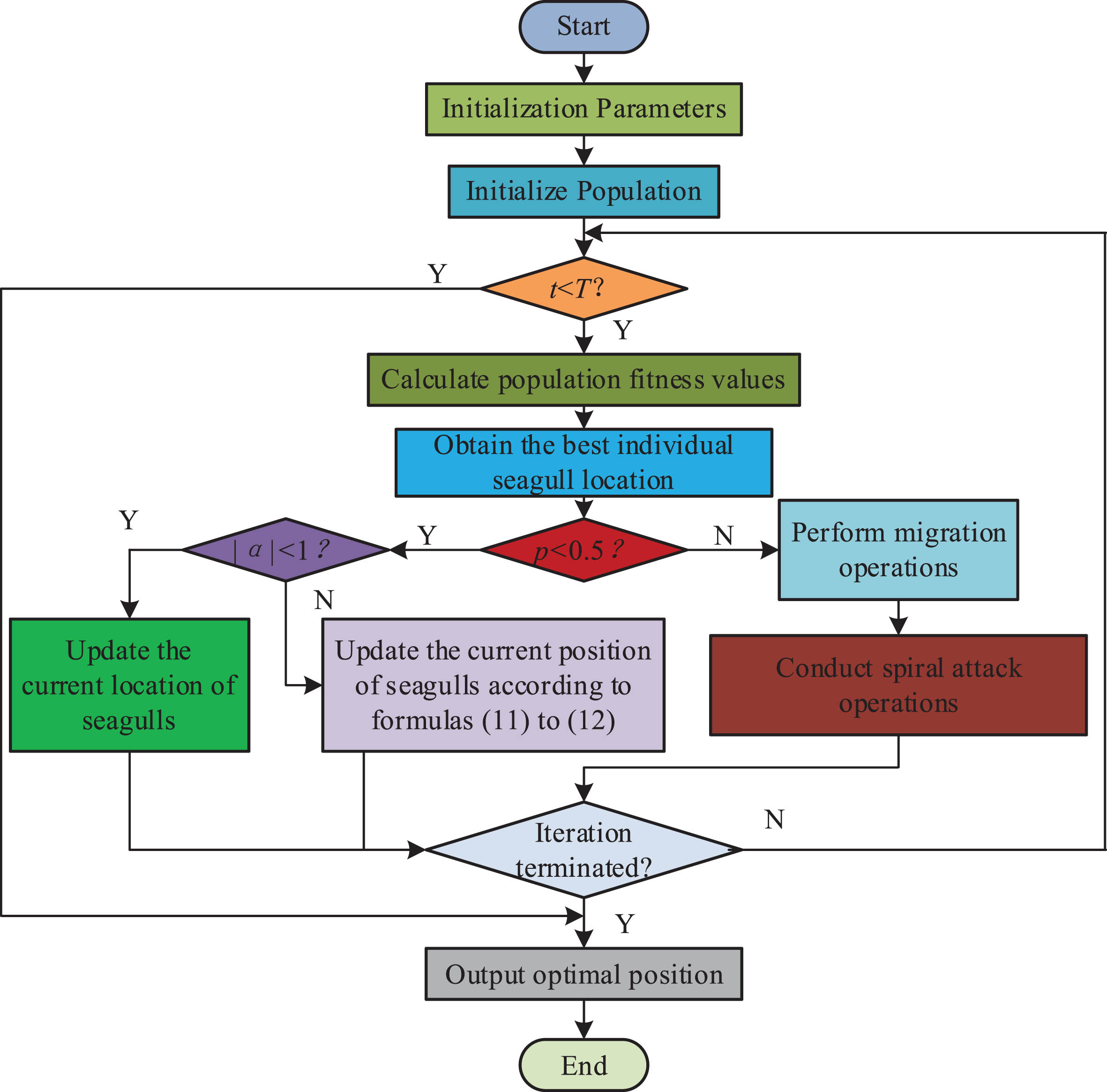
ISOA-BPNN is used to build a model to achieve intelligent prediction of HRM risks, improve the efficiency of HRM in enterprises, and ensure stable and sustainable development of enterprises. The ISOA-BPNN HRM risk intelligent prediction model is shown in Fig. 2.
Fig. 2
ISOA-BPNN HRM risk intelligent prediction model.
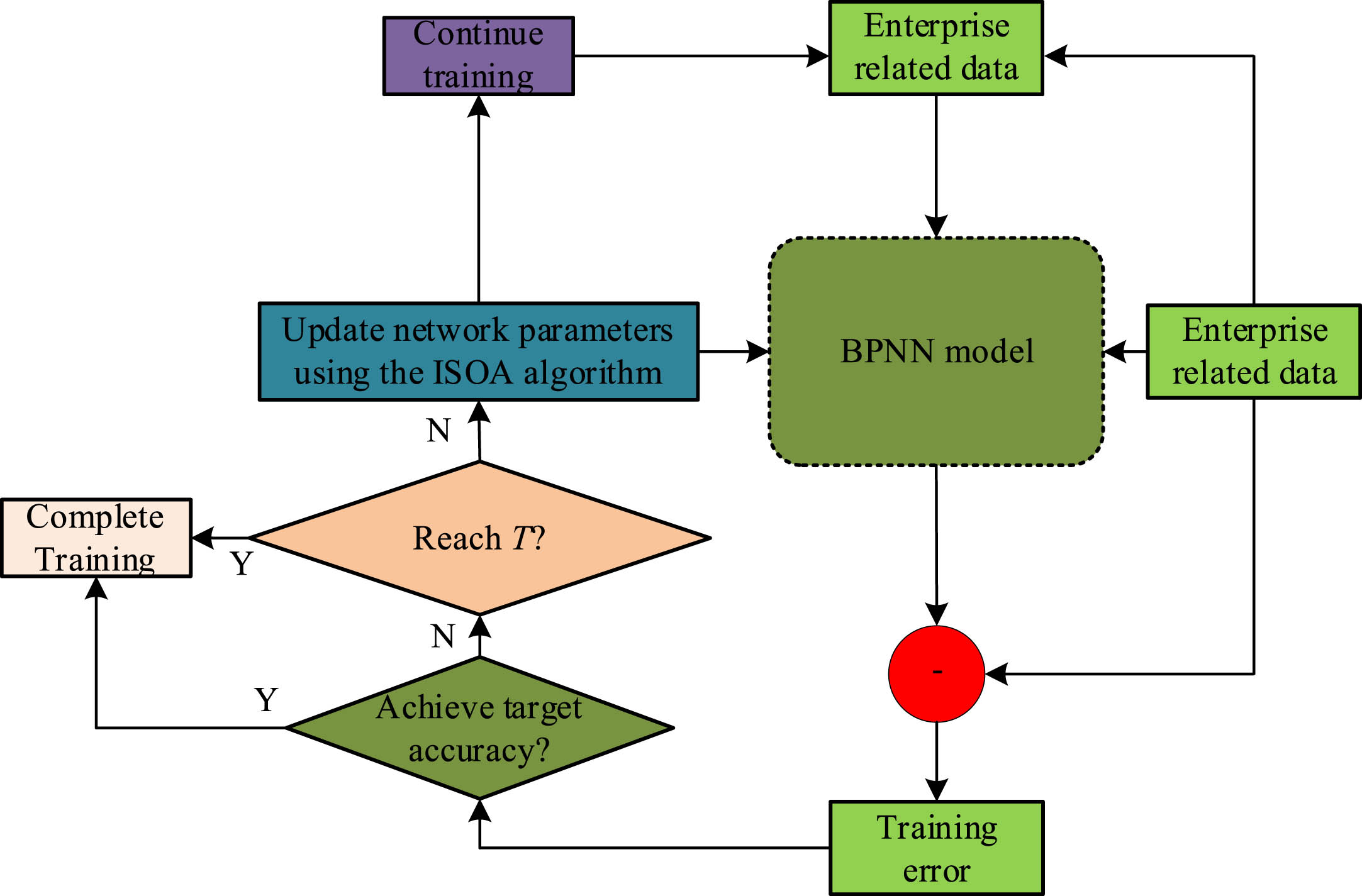
3Performance analysis of ISOA-BPNN HRM risk prediction model
To improve the efficiency and accuracy of enterprise HRM risk prediction, the study proposes an ISOA-BPNN model to achieve intelligent prediction of HRM risk. With consent, the experimental data set is constructed by obtaining relevant data in an enterprise’s management system. The experimental dataset is divided into two sample sets in the ratio of 7:3, which are the training and the test sample set. There are two advanced intelligent prediction models for enterprise HRM risk, which are GA-BPNN model and Bayesian network (BN) model. The performance of several models is analyzed by comparing the effectiveness of ISOA-BPNN model, GA-BPNN model and BN model in the intelligent prediction of enterprise HRM risk. First, the validity of the four public factors extracted by PCA is verified. The gravel plot of the public factors is shown in Fig. 3. The slope of the trend line where the extracted 4 public factors are located is greater, while the slope of the trend line where the other factors are located is flatter. The above results can show that the extracted 4 public factors can reflect the enterprise HRM situation more effectively and comprehensively, so as to effectively analyze and predict the enterprise HRM risks.
Fig. 3
Gravel diagram of common factors.
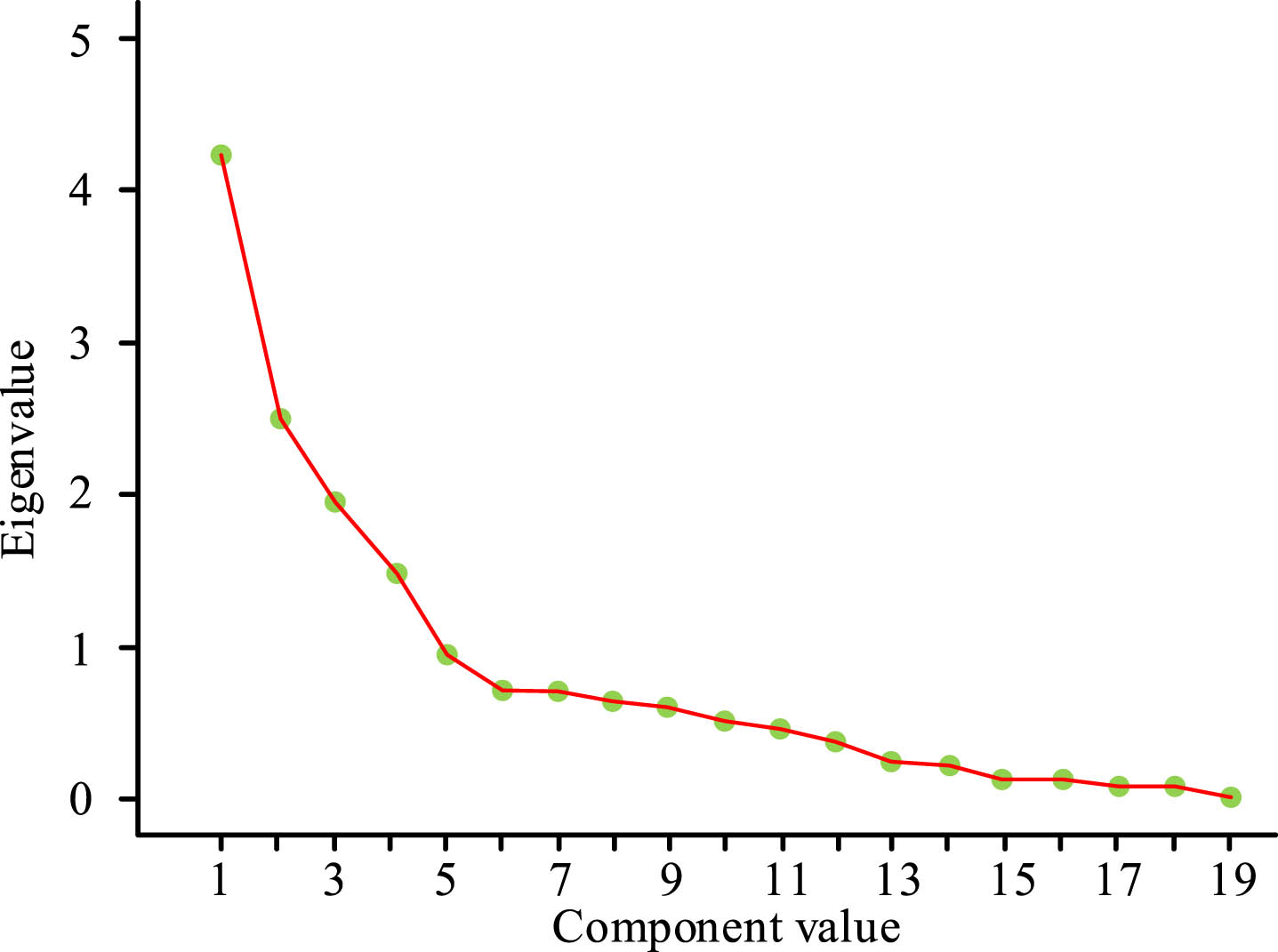
In the process of training the ISOA-BPNN model, GA-BPNN and BN model using the training sample set, the variation of the error and Loss values of the three models are shown in Fig. 4. In Fig. 4, the number of iterations required for the ISOA-BPNN model to reach the optimal error and Loss values is 102, which is 48 and 97 times less than that of the GA-BPNN and the BN, respectively. It indicates that the ISOA-BPNN model has better convergence. In Fig. 4(a), the ISOA-BPNN model error value is 0.02, which is 0.01 and 0.02 lower than the GA-BPNN and the BN. In Fig. 4(b), the ISOA-BPNN model has a Loss value of 0.50, which is 0.43 and 0.68 lower than the GA-BPNN and the BN. The above shows that in HRM intelligent prediction of risk, the ISOA-BPNN model has higher convergence and therefore has higher efficiency in performing intelligent prediction of HRM risk.
Fig. 4
Changes in error and loss values for three models.
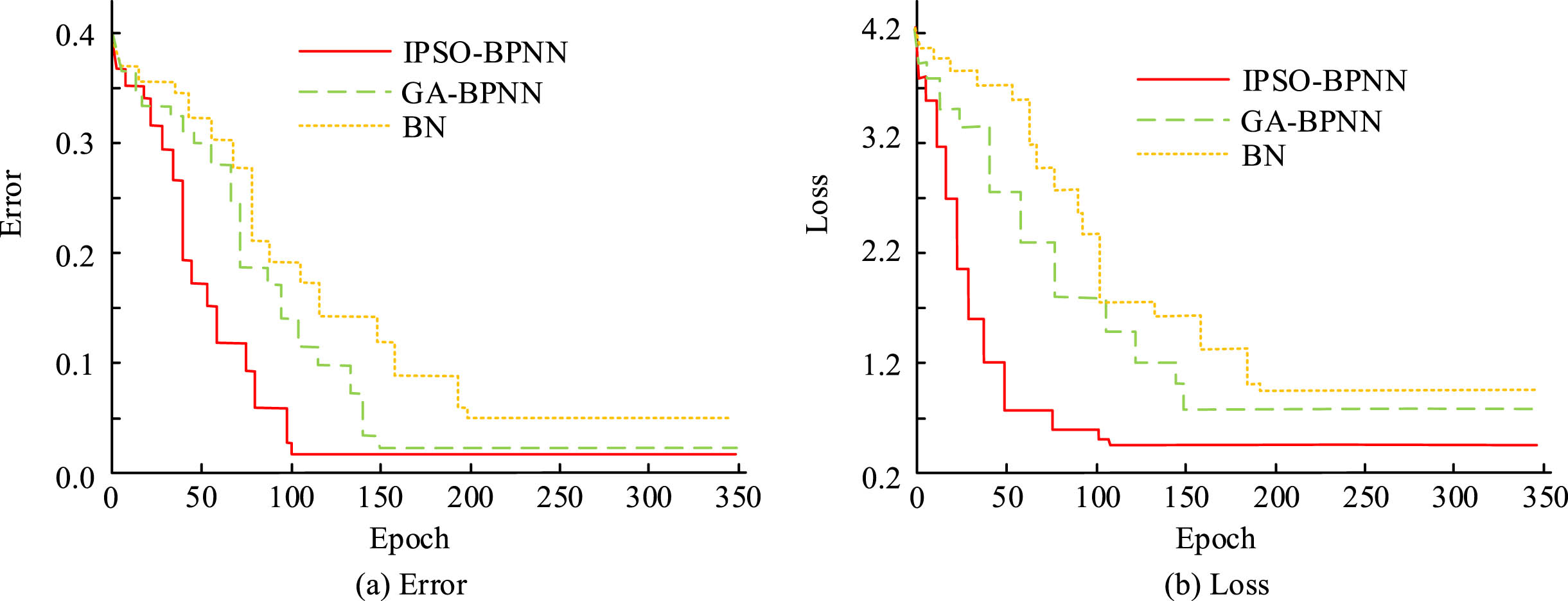
During the performance testing of the ISOA-BPNN, GA-BPNN, and BN model using the test sample set, the F1 and Recall values of the three models vary are expressed in Fig. 5. In Fig. 5(a), the F1 value of the ISOA-BPNN model reaches 95.7%, which is 1.1% and 1.6% higher than the other two models. In Fig. 5(b), the ISOA-BPNN model Recall value reaches 94.9%, which is 0.6% and 1.5% higher than the GA-BPNN and the BN. The above data indicate that the ISOA-BPNN model outperforms the GA-BPNN and the BN in the intelligent prediction of HRM risks.
Fig. 5
Changes in F1 and recall values for three models.
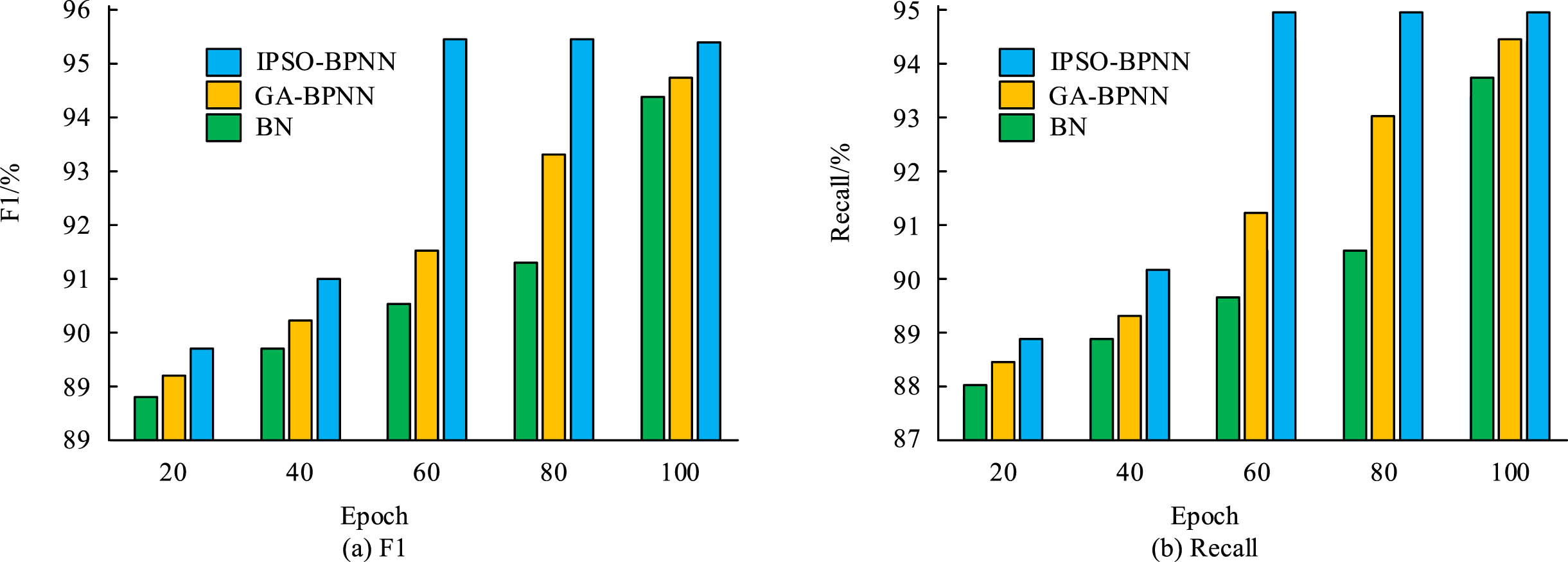
The MSE and MAE values of the three models vary as displayed in Fig. 6. In Fig. 6(a), the MSE value of the ISOA-BPNN model is 0.31, which is 0.4 and 0.8 lower than that of the GA-BPNN model and the BN model, respectively. In Fig. 6(b), the MAE value of the ISOA-BPNN model is 8.4, which is 1.2 and 1.7 lower than that of the GA-BPNN and the BN, respectively. The above can indicate that for the intelligent prediction of HRM risk, the ISOA-BPNN model has lower prediction error.
Fig. 6
Changes in MSE and MAE values for three models.
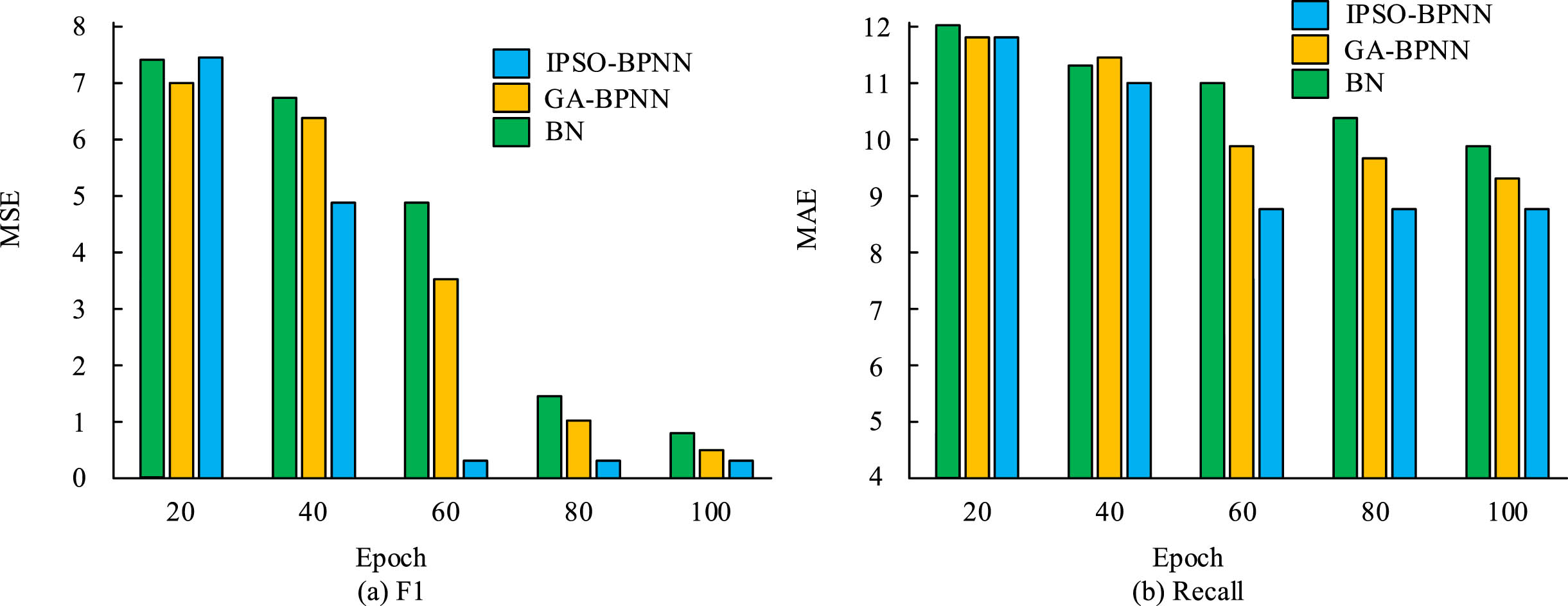
Three models’ accuracy variations are expressed in Fig. 7. In Fig. 7, the accuracy rate of ISOA-BPNN model reaches 99.53%, which is 0.92% and 1.43% higher than GA-BPNN model and BN model, respectively. The above results can show that the ISOA-BPNN model has higher prediction accuracy and better prediction in the intelligent prediction of HRM risk.
Fig. 7
Change in accuracy of three models.
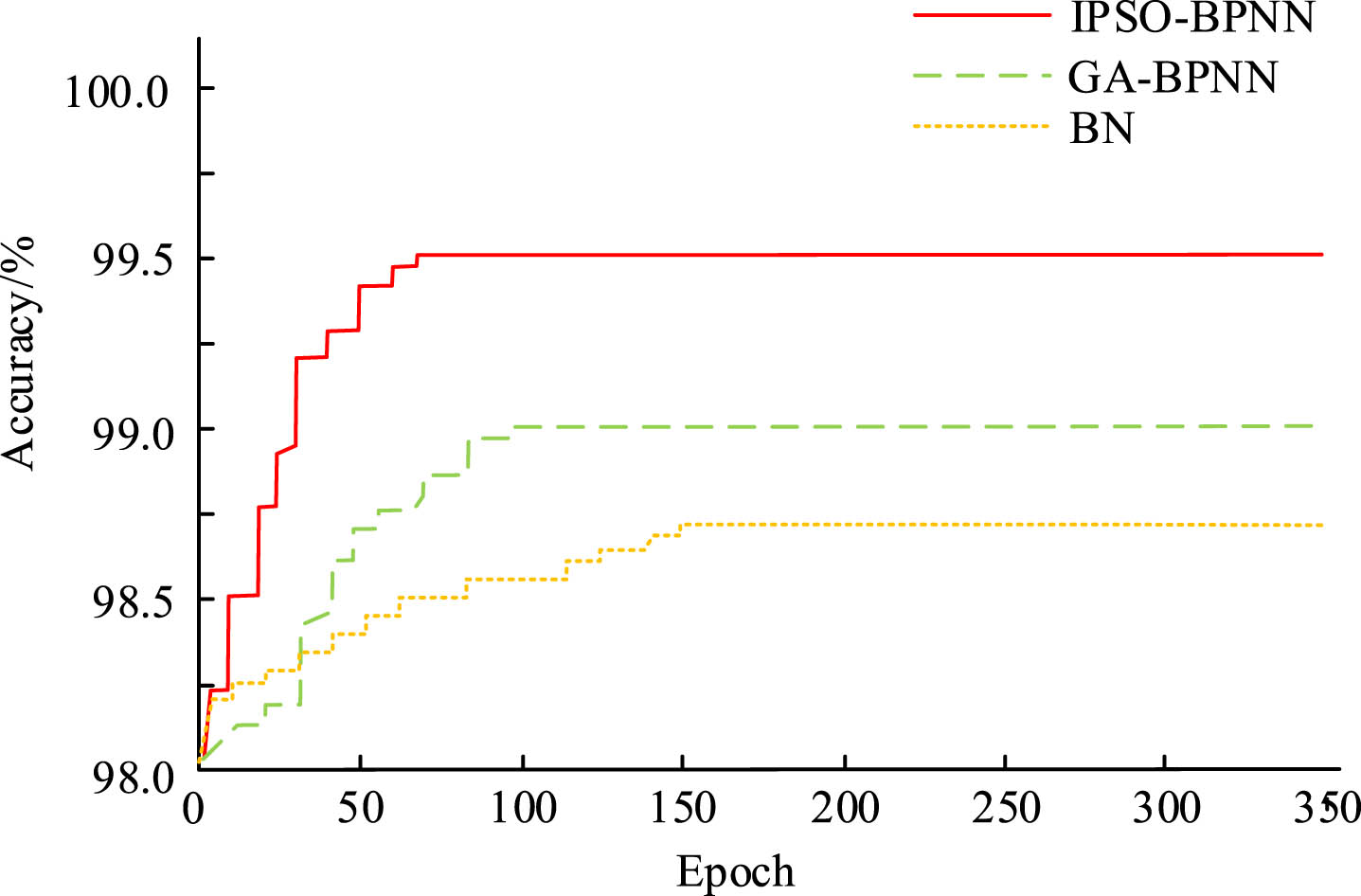
The trend changes of the ROC curves of the three models are shown in Fig. 8. The AUC value of the ISOA-BPNN model reaches 0.993, which is 0.012 and 0.025 higher than that of the GA-BPNN model and the BN model, respectively. The above results can indicate that the ISOA-BPNN model has better comprehensive performance and better prediction effect in the intelligent prediction of HRM risks. The synthesis of the above can be learned that the study of the intelligent prediction model of HRM risk constructed based on ISOA-BPNN has higher accuracy and efficiency, and better prediction of HRM risk in enterprises. Therefore, the model can well achieve the intelligent prediction of HRM risks, thus providing data support for HRM decision-making. It has a positive effect on the stable and sustainable development of enterprises, and also has a certain role in promoting the development of China’s market economy.
Fig. 8
Trend change of ROC curve of three models.
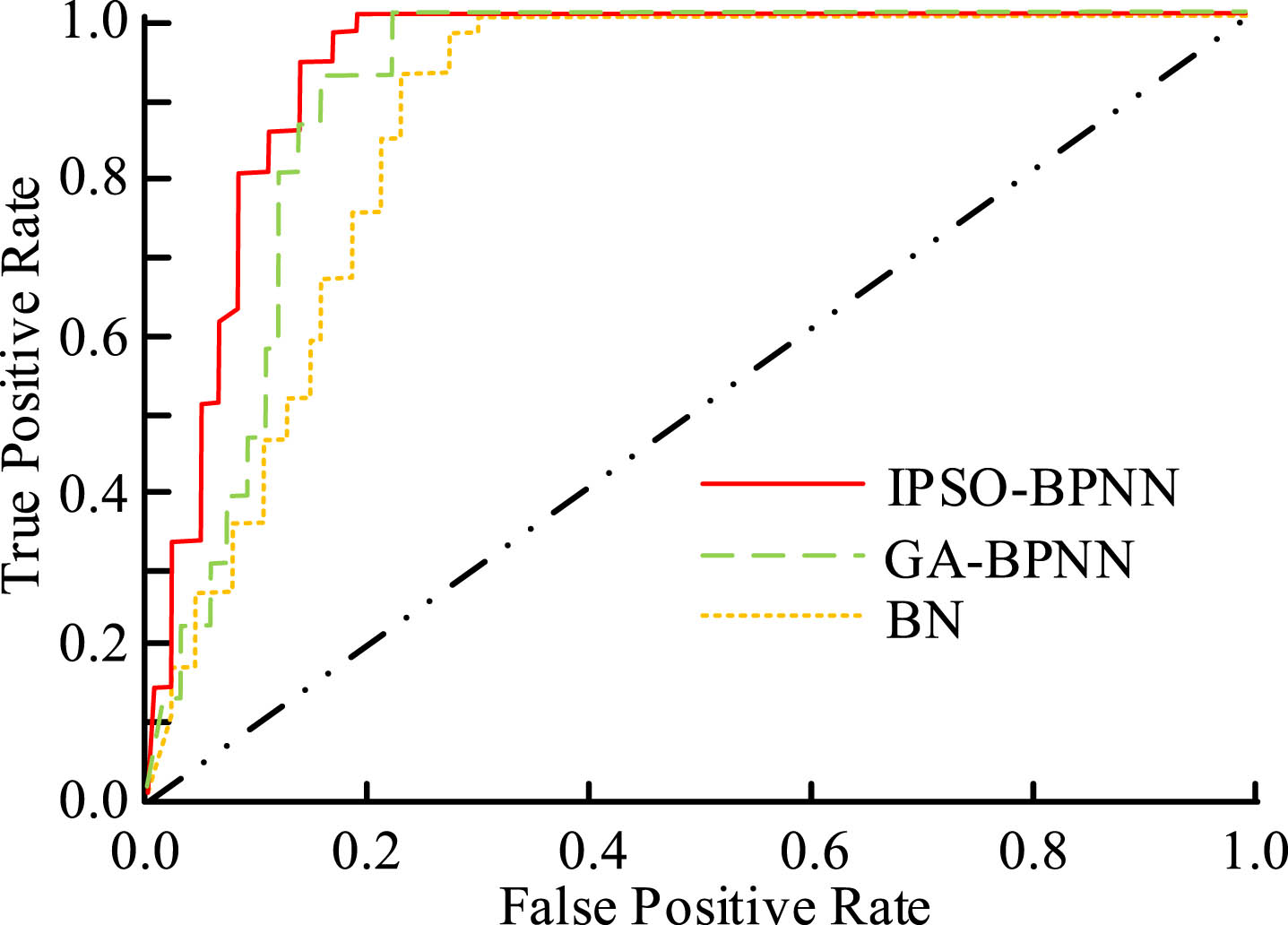
4Conclusion
HRM risk prediction is one of the important tasks in the process of enterprise development, which can help enterprises avoid HRM risks and promote the stable development of enterprises. The current HRM risk prediction methods have low efficiency and accuracy. For this reason, the study proposes an intelligent HRM risk prediction model constructed based on ISOA-BPNN. The research results indicate that the number of iterations required for the ISOA-BPNN model to reach the optimal error value and Loss value is 102, which is 48 and 97 times less than the GA-BPNN and BN model, respectively; The error value is 0.02, which is 0.01 and 0.02 lower than the other two; The Loss value is 0.50, which is 0.50 lower than the others; F1 value reached 95.7%, 1.1% and 1.6% higher than GA-BPNN and BN; Recall value reached 94.9%, exceeds 0.6% and 1.5%; MSE value was 0.31, 0.4 and 0.8 lower than GA-BPNN model and BN model, respectively; MSE value was 0.31, 0.4 and 0.8 lower than GA-BPNN model and BN model, respectively. The MAE value was 8.4, which was 1.2 and 1.7 lower than the GA-BPNN and BN; The accuracy reached 99.53%, which was 0.92% and 1.43% higher than the two models; The AUC value reached 0.993, which was 0.012 and 0.025 higher than the GA-BPNN and BN models, respectively. In summary, the intelligent prediction model of HRM risk constructed based on ISOA-BPNN has higher accuracy and efficiency, and has a better prediction effect on enterprise HRM risk. However, there are still some shortcomings, and follow-up research can be improved from the following aspects: (1) The data used in the study process of the experiment is only from one company, which may lead to certain deviations in the experimental results. Therefore, it is necessary to expand the sample range and eliminate experimental bias in follow-up studies. (2) Due to the numerous types of HRM risk factors, the prevention and control of HRM risks is bound to be a complex system engineering. Therefore, how to use deep learning technology for effective prevention and control based on HRM risk prediction is also a research direction with practical significance.
Author contributions
CONCEPTION: Min Ding
METHODOLOGY: Min Ding, Hao Wu
DATA COLLECTION: Hao Wu
INTERPRETATION OR ANALYSIS OF DATA: Hao Wu, Min Ding
PREPARATION OF THE MANUSCRIPT: Hao Wu
REVISION FOR IMPORTANT INTELLECTUAL CONTENT: Min Ding
SUPERVISION: Min Ding, Hao Wu
Acknowledgments
The authors have no acknowledgments.
References
[1] | Vrontis D , Christofi M , Pereira V , Tarba S , Makrides A , Trichina E . Artificial intelligence, robotics, advanced technologies and human resource management: A systematic review. The International Journal of Human Resource Management. (2022) ;33: (6):1237–66. https://doi.org/10.1080/09585192.2020.1871398 |
[2] | Collins CJ . Expanding the resource based view model of strategic human resource management. The International Journal of Human Resource Management. (2021) ;32: (2):331–58. https://doi.org/10.1080/09585192.2019.1711442 |
[3] | Bonache J , Festing M . Research paradigms in international human resource management: An epistemological systematisation of the field. German Journal of Human Resource Management. (2020) ;34: (2):99–123. https://doi.org/10.1177/2397002220909780 |
[4] | Lee J . Integration of digital twin and deep learning in cyber-physical systems: Towards smart manufacturing. (2020) ;38: (8):901–10. https://doi.org/10.1049/iet-cim.2020.0009 |
[5] | Barbu T . Deep learning-based multiple moving vehicle detection and tracking using a nonlinear fourth-order reaction-diffusion based multi-scale video object analysis. Discrete and Continuous Dynamical Systems - S. (2023) ;16: (1):16–32. https://doi.org/10.3934/dcdss.2022083 |
[6] | Berhil S , Benlahmar H , Labani N . A review paper on artificial intelligence at the service of human resources management. Indonesian Journal of Electrical Engineering and Computer Science. (2020) ;18: (1):32–40. https://doi.org/10.11591/ijeecs.v18.i1.pp32-40 |
[7] | Carnevale JB , Hatak I . Employee adjustment and well-being in the era of COVID-19: Implications for human resource management. Journal of Business Research. (2020) ;116: :183–7. https://doi.org/10.1016/j.jbusres.2020.05.037 |
[8] | Yong JY , Yusliza MY , Fawehinmi OO . Green human resource management: A systematic literature review from 2007 to 2019. Benchmarking: An International Journal. (2020) ;27: (7):2005–27. https://doi.org/10.1108/BIJ-12-2018-0438 |
[9] | Pham NT , Hoang HT , Phan QPT . Green human resource management: A comprehensive review and future research agenda. International Journal of Manpower. (2020) ;41: (7):845–78. https://doi.org/10.1108/IJM-07-2019-0350 |
[10] | Cross D , Swart J . The (ir) relevance of human resource management in independent work: Challenging assumptions. Human Resource Management Journal. (2022) ;32: (1):232–46. https://doi.org/10.1111/1748-8583.12389 |
[11] | Kougiannou NK , Ridgway M . How is human resource management research (not) helping practice? In defence of practical implications. Human Resource Management Journal. (2022) ;32: (2):470–84. https://doi.org/10.1111/1748-8583.12414 |
[12] | Putra R , Ali H . Organizational behavior determination and decision making: Analysis of skills, motivation and communication (literature review of human resource management). Dinasti International Journal of Digital Business Management. (2022) ;3: (3):420–31. https://doi.org/10.31933/dijdbm.v3i3.1168 |
[13] | Ansari NY , Farrukh M , Raza A . Green human resource management and employees pro-environmental behaviours: Examining the underlying mechanism. Corporate Social Responsibility and Environmental Management. (2021) ;28: (1):229–38. https://doi.org/10.1002/csr.2044 |
[14] | Han JX , Ma MY , Wang K . Product modeling design based on genetic algorithm and BP neural network. Neural Computing and Applications. (2021) ;33: :4111–7. https://doi.org/10.1007/s00521-020-05604-0 |
[15] | Li T , Sun J , Wang L . An intelligent optimization method of motion management system based on BP neural network. Neural Computing and Applications. (2021) ;33: :707–22. https://doi.org/10.1007/s00521-020-05093-1 |
[16] | Chen L , Jagota V , Kumar A . RETRACTED ARTICLE: Research on optimization of scientific research performance management based on BP neural network. International Journal of System Assurance Engineering and Management. (2023) ;14: (1):489–489. https://doi.org/10.1007/s13198-021-01263-z |
[17] | Li YW , Cao K . Establishment and application of intelligent city building information model based on BP neural network model. Computer Communications. (2020) ;153: :382–9. https://doi.org/10.1016/j.comcom.2020.02.013 |
[18] | Wu Y , Gao R , Yang J . Prediction of coal and gas outburst: A method based on the BP neural network optimized by GASA. Process Safety and Environmental Protection. (2020) ;133: :64–72. https://doi.org/10.1016/j.pse2019.10.002 |
[19] | Tang S , Yu F . Construction and verification of retinal vessel segmentation algorithm for color fundus image under BP neural network model. The Journal of Supercomputing. (2021) ;77: :3870–84. https://doi.org/10.1007/s11227-020-03422-8 |
[20] | Zhang D , Lou S . The application research of neural network and BP algorithm in stock price pattern classification and prediction. Future Generation Computer Systems. (2021) ;115: :872–9. https://doi.org/10.1016/j.future.2020.10.009 |
[21] | Jiang Q . Estimation of construction project building cost by back-propagation neural network. Journal of Engineering, Design and Technology. (2020) ;18: (3):601–9. https://doi.org/10.1108/JEDT-08-2019-0195 |




